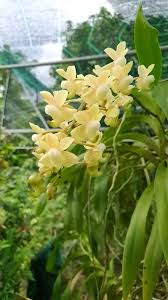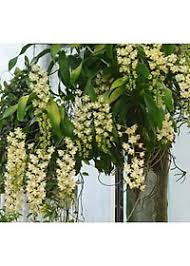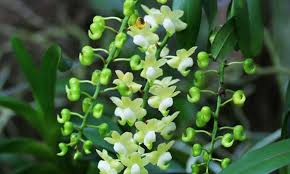
Quế Lan Hương, commonly known as the fragrant orchid, is a stunning species belonging to the Dendrobium genus. Renowned for its exquisite blooms and delightful aroma, this orchid is not only popular among horticulturists but also cherished in various cultures for its symbolic significance. When relocating Quế Lan Hương to a new environment, it is crucial to ensure a smooth transition that fosters healthy growth and adaptation. This comprehensive guide explores strategies to help Quế Lan Hương acclimatize effectively, covering factors such as environmental conditions, care techniques, and common challenges.
## 1. Understanding Quế Lan Hương’s Natural Habitat
### A. Native Environment
Quế Lan Hương is native to Southeast Asia, particularly thriving in tropical and subtropical regions. It typically grows as an epiphyte on trees, where it benefits from dappled sunlight and high humidity. Understanding its natural habitat is essential for creating similar conditions in a new environment.
### B. Environmental Needs
To help Quế Lan Hương adapt, it is vital to replicate the following environmental factors:
– **Temperature**: This orchid prefers temperatures between 20°C to 30°C (68°F to 86°F) during the day and slightly cooler at night.
– **Humidity**: Quế Lan Hương thrives in high humidity, ideally around 60% to 80%. Maintaining adequate humidity is crucial for its growth.
– **Light**: Bright, indirect light is necessary for healthy growth and flowering. Too much direct sunlight can scorch the leaves, while insufficient light can hinder flowering.
## 2. Preparing for the Relocation
### A. Choosing the Right Time
Timing is crucial when relocating Quế Lan Hương. The best time for relocation is during its dormant phase, usually in late fall or winter. This period minimizes stress and allows the plant to acclimatize to its new environment without the pressure of active growth.
### B. Assessing the New Location
Before moving the orchid, assess the new environment for the following factors:
– **Light Conditions**: Determine the amount of natural light available in the new location. Ensure it aligns with Quế Lan Hương’s light requirements.
– **Temperature Fluctuations**: Check for any potential temperature fluctuations that could stress the orchid. Avoid locations near heating vents, air conditioning units, or drafty windows.
– **Humidity Levels**: Measure the humidity in the new environment. If it’s too low, consider using a humidifier or placing a humidity tray with water and pebbles near the orchid.
## 3. The Relocation Process
### A. Preparing the Orchid for Move
Before relocating Quế Lan Hương, take the following steps to prepare:
1. **Pruning**: Remove any dead or damaged leaves and spent flower spikes to encourage new growth and reduce stress during the move.
2. **Inspecting for Pests**: Check for pests or diseases and treat them before relocating the orchid. This prevents the spread of any issues to the new environment.
### B. Safe Transportation
When transporting Quế Lan Hương, consider the following tips to ensure its safety:
– **Secure the Plant**: Use a sturdy container to prevent the orchid from tipping over or being damaged during transport. If the orchid is potted, avoid disturbing the roots.
– **Protect from Elements**: Shield the orchid from direct sunlight and extreme temperatures during transportation. Cover it with a light cloth if necessary to minimize stress.
## 4. Acclimating Quế Lan Hương to the New Environment
### A. Gradual Introduction to New Conditions
To help Quế Lan Hương adapt to its new environment, introduce it gradually:
1. **Light Adjustment**: If the new location has brighter light, gradually expose the orchid to higher light levels over a week to prevent shock.
2. **Temperature Acclimatization**: If the temperature differs significantly, allow the orchid to adjust slowly. Avoid placing it in extreme temperature zones right away.
### B. Monitoring Watering Needs
Quế Lan Hương’s watering needs may change in the new environment. Monitor the following:
– **Soil Moisture**: Check the potting medium regularly. Adjust your watering schedule based on the humidity and temperature levels in the new location.
– **Signs of Stress**: Watch for signs of overwatering or underwatering, such as yellowing leaves or wilting. Adjust accordingly to maintain healthy moisture levels.
### C. Providing Adequate Humidity
Since Quế Lan Hương thrives in high humidity, consider the following methods to maintain adequate moisture levels:
1. **Humidifiers**: Use a humidifier in the room where the orchid is placed to maintain a consistent humidity level.
2. **Humidity Trays**: Place the pot on a humidity tray filled with water and pebbles. This creates a microclimate that enhances humidity around the plant.
## 5. Care Techniques for Healthy Adaptation
### A. Fertilization Adjustments
After relocating Quế Lan Hương, adjust its fertilization routine:
– **Balanced Fertilizer**: Use a balanced fertilizer specifically formulated for orchids. Fertilize every 2-4 weeks during the growing season, but reduce frequency during the dormant period.
– **Water-Soluble Options**: Consider using water-soluble fertilizers to ensure even distribution and prevent salt buildup in the potting medium.
### B. Pruning and Grooming
Continued care after relocation includes regular pruning and grooming:
– **Removing Dead Material**: Regularly remove any dead leaves or spent flowers to promote airflow and prevent diseases.
– **Reassessing Shape**: If needed, prune for shape to maintain a compact and aesthetically pleasing form.
## 6. Common Challenges and Solutions
### A. Stress Signs and Symptoms
After relocating, Quế Lan Hương may show signs of stress. Common symptoms include:
– **Yellowing Leaves**: This may indicate overwatering or insufficient light.
– **Wilting**: Wilting leaves can signal underwatering or inadequate humidity levels.
### B. Troubleshooting Techniques
If you notice signs of stress, take the following steps to address the issue:
– **Adjust Watering**: Reevaluate your watering schedule and ensure the potting medium is draining properly.
– **Optimize Light Conditions**: If the orchid isn’t receiving enough light, consider moving it closer to a light source while avoiding direct sunlight.
### C. Pest and Disease Management
Relocation can also expose Quế Lan Hương to pests and diseases. Common pests include aphids and mealybugs. Implement the following strategies:
– **Regular Inspections**: Frequently inspect the plant for pests and diseases. Early detection is crucial for effective management.
– **Natural Remedies**: Use insecticidal soap or neem oil to control pest populations without harming the orchid.
## 7. Long-Term Care for Quế Lan Hương
### A. Ongoing Environmental Monitoring
After successfully relocating Quế Lan Hương, continue to monitor the environmental conditions:
– **Temperature Checks**: Regularly check temperature levels to ensure they remain within the ideal range for the orchid.
– **Humidity Maintenance**: Keep an eye on humidity levels, adjusting your methods as needed to maintain optimal moisture.
### B. Seasonal Adjustments
As seasons change, so do the needs of Quế Lan Hương. Adjust your care routine accordingly:
– **Winter Care**: During the colder months, reduce watering frequency as the plant enters a dormant period. Ensure it is not exposed to drafts or extreme cold.
– **Spring Revitalization**: As temperatures rise in spring, increase watering and fertilization to encourage new growth and flowering.
## 8. Conclusion
Helping Quế Lan Hương adapt to a new environment requires careful planning, observation, and ongoing care. By understanding the orchid’s natural habitat and providing the right conditions, you can ensure a smooth transition and promote healthy growth.
From preparing the orchid for relocation to addressing common challenges, each step plays a crucial role in fostering a successful acclimatization process. By following the guidelines outlined in this article, you can enjoy the beauty and fragrance of Quế Lan Hương in its new home, creating a vibrant and flourishing addition to your plant collection.
With dedication and patience, your Quế Lan Hương will not only survive but thrive, offering joy and elegance for years to come. Embrace the journey of nurturing this exquisite orchid, and let its captivating blooms and delightful fragrance enhance your living space.


